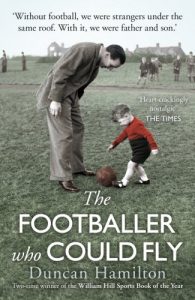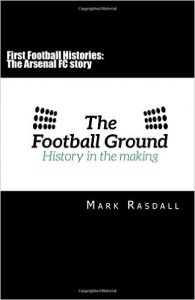Book Review: The Footballer Who Could Fly by Duncan Hamilton
 The Footballer Who Could Fly is a well-written but inconsistent book. That it is well-written is not surprising since Duncan Hamilton is two-time winner of the William Hill Sports Book of the Year award (2007 & 2009) and his reputation alone is probably the reason why it was longlisted for the 2012 one. It is inconsistent because he is trying to do two things at the same time; look back on football in bygone days and explore the difficult relationship he had with his father. Problems arise from the difficulties he has in combining the two. You don’t need to take the reviewer’s word for this as the publishers demonstrate it explicitly.
The Footballer Who Could Fly is a well-written but inconsistent book. That it is well-written is not surprising since Duncan Hamilton is two-time winner of the William Hill Sports Book of the Year award (2007 & 2009) and his reputation alone is probably the reason why it was longlisted for the 2012 one. It is inconsistent because he is trying to do two things at the same time; look back on football in bygone days and explore the difficult relationship he had with his father. Problems arise from the difficulties he has in combining the two. You don’t need to take the reviewer’s word for this as the publishers demonstrate it explicitly.
When the book was first published, in hardback by Century, the cover had a photograph of Wyn Davies, the Newcastle striker famed for his prodigious leaps and ability to ‘hang in the air’ before heading the ball – hence the book’s title. When it was released the following year (2013) by Windmill in paperback, the cover was changed to an affecting one of a father and small son playing football in the park. Both covers carried the banner clue to the contents, ‘Without football, we were strangers under the same roof. With it, we were father and son.’ To make such a significant change points to the consumer uncertainty of what the book was actually about affecting hardback sales.
The main profiles of footballers and managers are thematically linked to the father-son dynamic; Jock Stein, Matt Busby and Bill Shankly were all Scots ex-miners (like Hamilton’s father) and they all had a paternalistic style of management, whilst Hamilton’s working relationship with Brian Clough, a fascinating read, has clear father-son overtones. The players tend to fall into one of two categories; the son-figure made good like Duncan Edwards, Jackie Milburn and Bobby Charlton or the errant son like George Best and Jim Baxter who were profligate with their talent and ruined themselves with drink. The central son-figure in the book is Ray Kennedy, the local hero, from the very same village as the Hamiltons. Kennedy was frequently referred to by the senior Hamilton as, ‘our Seaton Delaval lad.’
Not everything is seen through the lens of the father-son relationship and, indeed, many of the best passages are when that is virtually forgotten and Hamilton becomes fully engaged in writing about some of the great names of the past. Particularly good is the profile a hero of Hamilton’s father, Jackie Milburn, who starred for Newcastle United, the team they supported. It is of special interest as we find out that his domineering father was the cause of Wor Jackie’s chronic lack of confidence despite all his brilliance. There is an implicit link to the author’s own relationship (he had a chronic stutter as a child) but Hamilton never goes anywhere near this. With modern wonders like YouTube, it is fascinating to see film of Milburn’s Cup Final goal against Blackpool in the knowledge that, in running to score from the halfway line, he is filled with the fear of being caught by the defenders. There is an effective completion of the cycle when Hamilton, in his journalistic career, sat next to an ageing Milburn in the press box as they covered a match, Milburn now the father figure to the young sports reporter.
The section on Duncan Edwards depicts a young star thankfully devoid of ego. (So much of the book is a corrective to the modern game of such super egos as Cristiano Ronaldo.) Doomed to die in the Munich air disaster aged 21, his reputation has stood the test of time and is firmly assured. It is pleasing, also, to read and be reminded about Danny Blanchflower of Spurs and Northern Ireland. He is an almost forgotten star today but his quality and influence as captain of the Double winning Tottenham side of 1961 is convincingly portrayed.
The most obvious example of author linking his father to the wider reminiscences relates to Jim Baxter, as the Hamiltons had relocated to Nottingham and Duncan’s father served the tons-of-Bacardi and little-bit-of-Coke swigging Baxter in a quiet bar and they had plenty of time to chat. Or, more precisely, allow Baxter to talk at length. There is a feeling that this episode inspired the whole book as Baxter, like Hamilton’s father, was an exiled Scot essentially living on memories of better days.
For all the interesting discussions of these players and managers, the whole dilemma with the book is the awkward relationship between father and son. Although mentioned frequently throughout, Hamilton seems to delay and delay a close investigation until virtually the end of the book, in the Afterword. A taciturn father is written about by a no longer tongue-tied son. The esteem Duncan Hamilton held for him is clear and perhaps the most poignant moment is after his father’s death when the son still instinctively reaches for the phone to speak to him about ‘an inconsequential football result’. The actual result being that this finally allows the son to grieve for his father.
There is more than a hint of him seeking posthumous approval and, surely, his father would have been proud of the book but, given the man he was and the society he came from, he might not have ever said as much. Whatever else this book might or might not be, it is a fine act of atonement.
Graeme Garvey
 The First Football Histories books are part of the output of The Football Ground Ltd company, which also includes the website
The First Football Histories books are part of the output of The Football Ground Ltd company, which also includes the website  There are some books you read which you immediately engage with and just can’t put down. Home and Away by Dave Roberts definitely falls into that category. The thing is that there isn’t just one thread within the book that lures you in, but several.
There are some books you read which you immediately engage with and just can’t put down. Home and Away by Dave Roberts definitely falls into that category. The thing is that there isn’t just one thread within the book that lures you in, but several. When writing about the history of Nottingham Forest, it is easy to focus on the period of success experienced under the management of Brian Clough; a time when you would seemingly wait a couple of seasons for an open-top bus tour of the Market Square then two would come along in quick succession. But there is more to Nottingham Forest than this – a history of otherwise infrequent success and near misses, along with early innovation, proceeded Clough’s appointment and that fateful day of 6 January 1975 is not reached until page 164 of this book.
When writing about the history of Nottingham Forest, it is easy to focus on the period of success experienced under the management of Brian Clough; a time when you would seemingly wait a couple of seasons for an open-top bus tour of the Market Square then two would come along in quick succession. But there is more to Nottingham Forest than this – a history of otherwise infrequent success and near misses, along with early innovation, proceeded Clough’s appointment and that fateful day of 6 January 1975 is not reached until page 164 of this book. In the modern age football feels like it is at saturation point in terms of coverage. Every detail about a player, manager or club is scrutinised to an infinite degree, so much so that nothing feels new, fresh or indeed inspiring.
In the modern age football feels like it is at saturation point in terms of coverage. Every detail about a player, manager or club is scrutinised to an infinite degree, so much so that nothing feels new, fresh or indeed inspiring. The 2016/17 FA Cup competition will begin on Saturday 06 August 2016, a fact that will come as a great surprise to those fans within the game who only acknowledge its existence come the Third Round in January.
The 2016/17 FA Cup competition will begin on Saturday 06 August 2016, a fact that will come as a great surprise to those fans within the game who only acknowledge its existence come the Third Round in January. itv seven is the second part of a trilogy which began with
itv seven is the second part of a trilogy which began with  Whenever FA Cup Final day comes around each season, you can be sure that a montage of winning goals from the Final’s down the years will be shown on television.
Whenever FA Cup Final day comes around each season, you can be sure that a montage of winning goals from the Final’s down the years will be shown on television.
 30 July 2016 will mark fifty years since England captain Bobby Moore raised aloft the World Cup at Wembley after a 4-2 victory over West Germany in the Final.
30 July 2016 will mark fifty years since England captain Bobby Moore raised aloft the World Cup at Wembley after a 4-2 victory over West Germany in the Final.